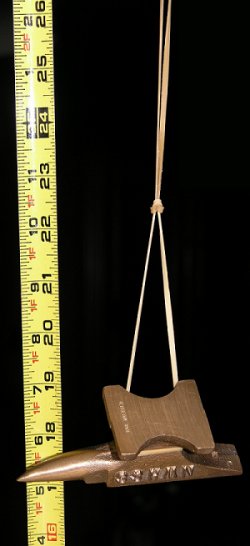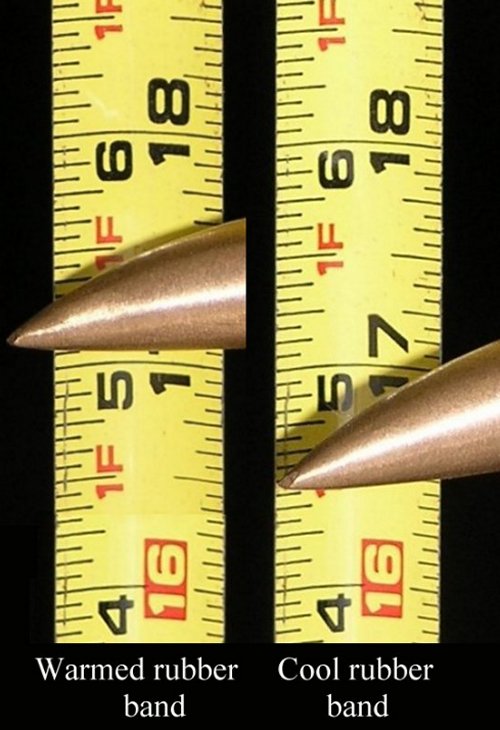Stretching
Today, let us stretch out imaginations. The University of Houston's College of Engineering presents this series about the machines that make our civilization run, and the people whose ingenuity created them.
Here's a simple enough question: When you stretch a steel wire, does it get hotter or colder? We've all bent a paperclip back and forth until it becomes very hot to the touch. So who wouldn't expect the stretched wire to heat up, as well.
Okay, try a little experiment: Find a rubber band. Grasp each end with one hand and hold it in front of your lip. Now, stretch it tightly, very suddenly, and touch it to your lip. You should find that it's warmed up. No big surprise. Next, keep it stretched tightly until it's back to room temperature. Then release it and touch it to your lip. This time, it's cooler.
 But now, another experiment with the same rubber band. Hang one end on a hook and tie a weight to the other end. What'll happen if we heat the rubber? The weight should sink downward, right? Well, warm the rubber band with a hair drier and just the opposite happens. It shrinks, and the weight rises. That seems crazy, yet it is what happens.
But now, another experiment with the same rubber band. Hang one end on a hook and tie a weight to the other end. What'll happen if we heat the rubber? The weight should sink downward, right? Well, warm the rubber band with a hair drier and just the opposite happens. It shrinks, and the weight rises. That seems crazy, yet it is what happens.
All these processes are interconnected by the same laws of thermodynamics -- for rubber, steel, or any other material. But if we hang a weight at the end of a steel wire, then heat the wire, we know it undergoes thermal expansion and the weight sinks.
So heat steel, and it expands -- heat rubber, and it shrinks. The same physics applies to both materials, but all the signs change. That means if you stretch steel, it cools down instead of warming up! Where does that leave us with our bent paper clip?
If we bend the paper clip just a little, it snaps back to its original shape. Its gripping power depends upon that action. But bend it too far, and the crystals of its steel deform. Then it heats up, and bending cannot be undone. The rules change when we exceed a material's elastic limit. Drive rubber too far and it also fails to snap back all the way. Let the air out of a balloon and it keeps a lot of its stretch permanently.
All this is just the tip of an iceberg of complication, of course. Stretch or bend certain metals (like, for example, the hardened steel of hacksaw blades) and, instead of deforming like paper clips, they just go plink -- they break in two all at once. Then, too, no material is perfectly elastic. Many metals, and certainly rubber, show a tiny bit of permanent distortion even when you think they've snapped all the way back.
These matters follow any engineer who has to design against stress. Just imagine how many issues of this kind someone sorted out to make your automobile work properly -- its piston rings, brakes, chassis, tires, springs. Think of the foam on the Shuttle's external tank or the motherboard in your computer.
Or see it another way. Think of the mental fun waiting for you when you decide to study engineering. Think of the kick, when it's you who anticipate trouble ahead of time -- when it's you who make things work the way they should.
I'm John Lienhard, at the University of Houston, where we're interested in the way inventive minds work.
For an elementary introduction to the behavior of stressed materials, see, one of the older engineering materials text, e.g., P. G. Laurson and W. J. Cox, Mechanics of Materials. (2nd ed.) (New York: John Wiley & Sons, Inc., 1947).
For a discussion of the thermodynamics of elastic strain of crystalline materials, see: J. F. Nye, Physical Properties of Crystals: Their Representation by Tensors and Matrices. (Oxford: Clarendon Press 1955/1984): Chapter X.
For a good introduction to materials science, see: J. F. Shackelford, Materials Science for Engineers. (6th ed.) (Upper Saddle River, NJ: Pear-son/Prentice Hall, 2005).
Thanks to my colleague, Lewis Wheeler for his invaluable counsel.
(Photos by John Lienhard)
